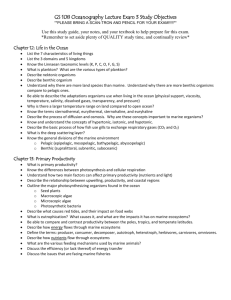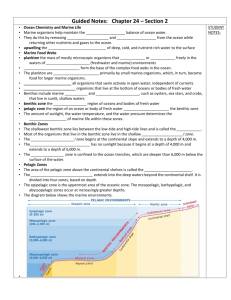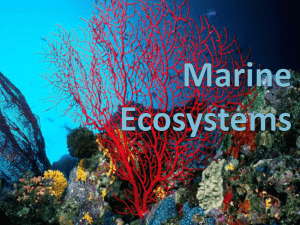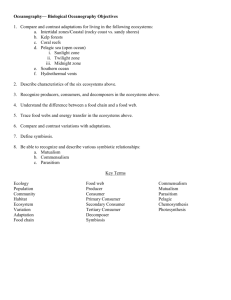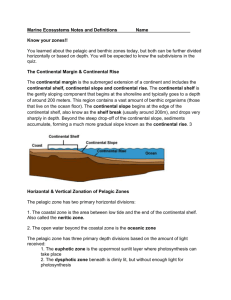13. Ocean Zones and Marine Ecosystems Notes
advertisement
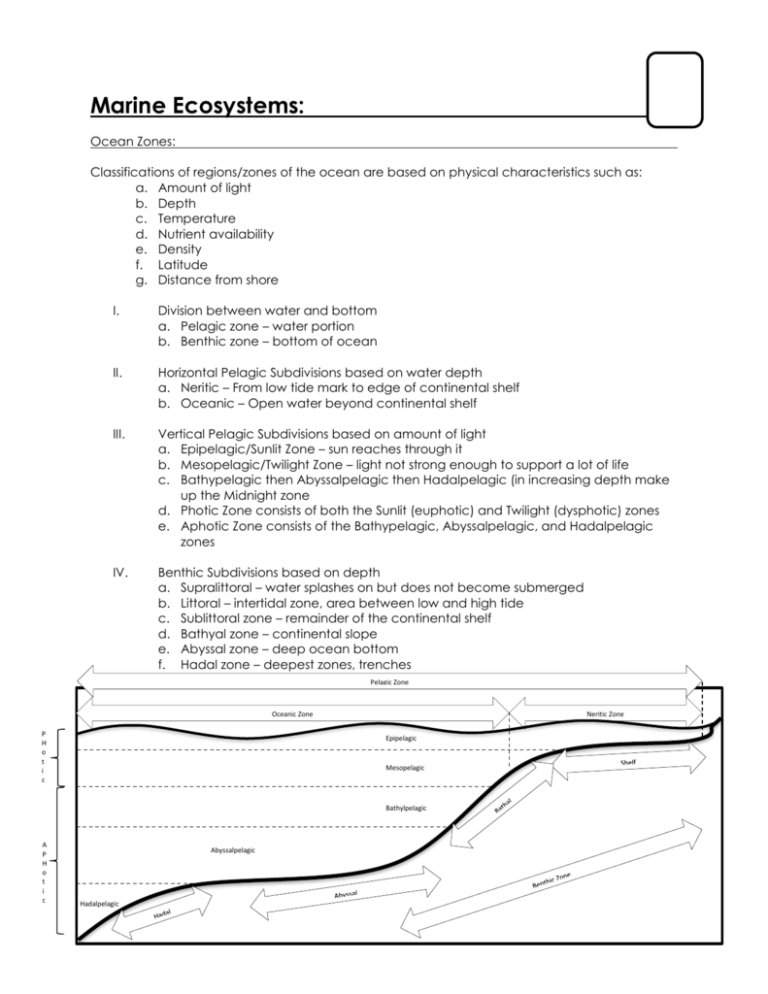
Marine Ecosystems: Ocean Zones: Classifications of regions/zones of the ocean are based on physical characteristics such as: a. Amount of light b. Depth c. Temperature d. Nutrient availability e. Density f. Latitude g. Distance from shore I. Division between water and bottom a. Pelagic zone – water portion b. Benthic zone – bottom of ocean II. Horizontal Pelagic Subdivisions based on water depth a. Neritic – From low tide mark to edge of continental shelf b. Oceanic – Open water beyond continental shelf III. Vertical Pelagic Subdivisions based on amount of light a. Epipelagic/Sunlit Zone – sun reaches through it b. Mesopelagic/Twilight Zone – light not strong enough to support a lot of life c. Bathypelagic then Abyssalpelagic then Hadalpelagic (in increasing depth make up the Midnight zone d. Photic Zone consists of both the Sunlit (euphotic) and Twilight (dysphotic) zones e. Aphotic Zone consists of the Bathypelagic, Abyssalpelagic, and Hadalpelagic zones IV. Benthic Subdivisions based on depth a. Supralittoral – water splashes on but does not become submerged b. Littoral – intertidal zone, area between low and high tide c. Sublittoral zone – remainder of the continental shelf d. Bathyal zone – continental slope e. Abyssal zone – deep ocean bottom f. Hadal zone – deepest zones, trenches Pelagic Zone Oceanic Zone P H o t i c Neritic Zone Epipelagic Mesopelagic Bathylpelagic A P H o t i c Abyssalpelagic Hadalpelagic Marine Ecosystems: Species – a single organism Population – a collection of the same species living in the same area Community – a collection of populations Ecosystem – A collection of communities with the same biotic (living) and abiotic (non-living) factors Open Ocean Ecosystems: a) Euphotic Zone - shallow open ocean, 1% of the ocean but a majority of marine life, supports photosynthesis, zone most affected by pollution and global warming b) Continental Shelf – neritic zone between the low tide mark to the edge of the continental shelf, high in nutrients due to upwelling, high light amounts, and heat retention Coastal Ecosystems: c) Estuaries – where ocean water meets rivers in a semi-enclosed area, highly biologically productive due to sediment runoff, organisms specially adapted to deal with changes in salinity d) Salt Marshes – located in estuaries and coasts with shallow slopes constantly enriched by tidal motion, high salinity due to evaporation e) Mangrove Swamps – swamps in which larger trees (Mangroves) whose roots provide an important safe environment for juvenile organisms and protect shorelines from erosion due to violent storms f) Seagrass Meadows – the only place where one can find true, vascular plants submerged under the water g) Intertidal Zones – areas such as the supralittoral zone (only splashed with water) and tide pools, where organisms must have adaptations to prevent drying out during low tides h) Beaches – Sandy regions that protect the shoreline, many organisms live within the sand and serve a large role in cleaning the water i) Kelp & Seaweed Forests – groups of algae that thrive in cooler, nutrient rich waters, which in turn provide an important source of food for many organisms j) Coral Reefs – one of the most diverse ecosystems in the world (water or land), need low nutrient waters to prevent competitions with other organisms and large amounts of light for photosynthesis, greatly affected by global warming, high diversity and low populations of organisms Polar Ecosystems: k) Arctic or Antarctic – extremely nutrient rich, drastic changes in productivity between winter and summer due to light and heat, low diversity and high populations of organisms, especially large whales Deep Sea Ecosystems: l) Abyssal Zone – nutrients provided by marine snow (sediment from dead animals and fecal matter), makes up most of the ocean, low density of life, very little information known about organisms m) Whale Falls – when a dead whale reaches the ocean floor, three stages: scavengers consume soft tissue over a couple months, then worms finish up the rest over a year, then bacteria breaks the rest down over a long period, possibly up to a decade n) Hydrothermal Vents – chemosynthetic bacteria convert the released sulfides, these bacteria then serve as the primary base of the deep ocean ecosystem

